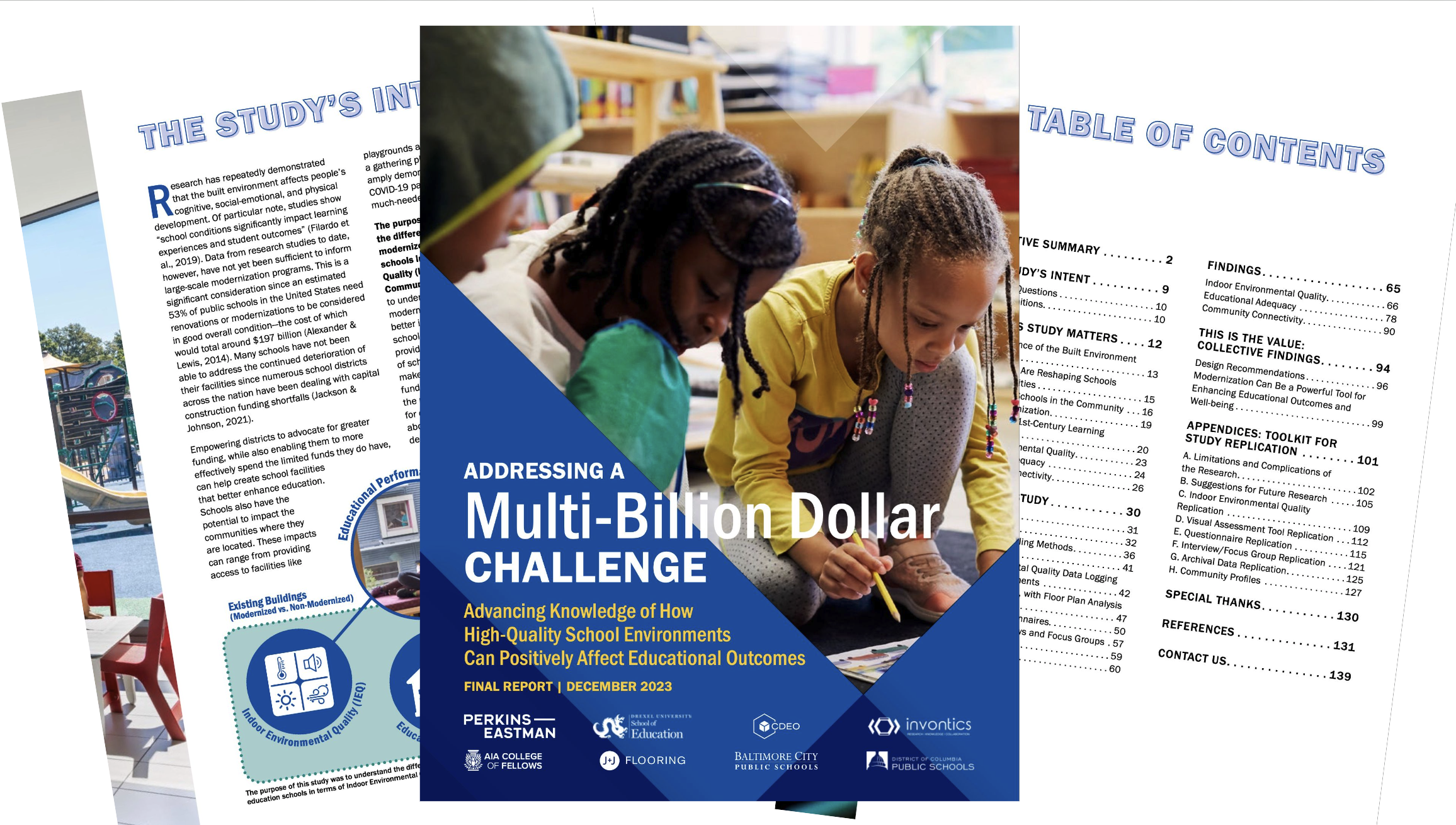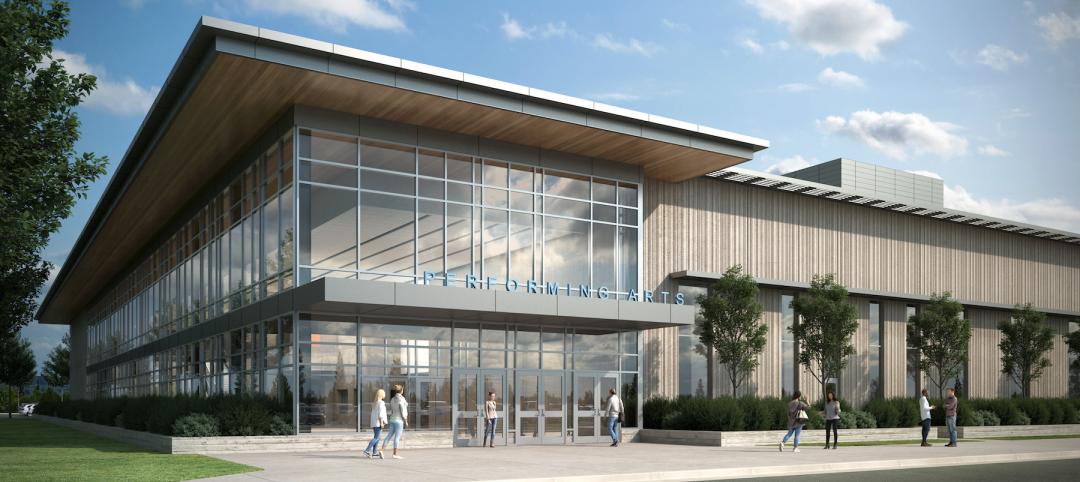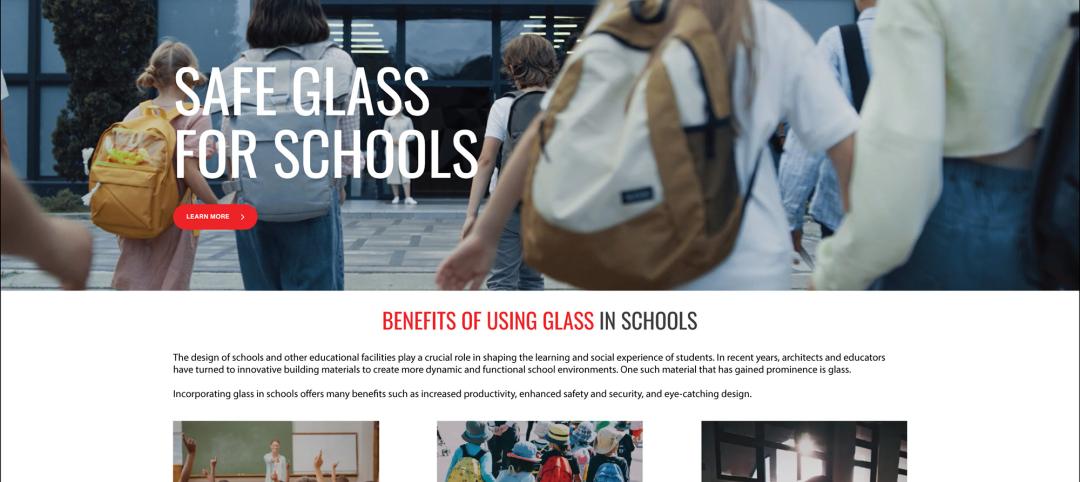The built environment matters. School districts that spend tax dollars to improve their schools can get much more than a new or renovated building. A new study suggests statistically significant connections between school modernization and occupants’ well-being and satisfaction; and that the modernization process enhances community engagement and connectivity. Evidence also indicates that school modernization has a significant positive impact on key educational indicators, including test scores, graduation rates, and enrollment over time.
Conducted by the Drexel University School of Education in conjunction with global design firm Perkins Eastman, the 140-page “Addressing a Multi-Billion Dollar Challenge” study (free download) evaluated more than two dozen schools—both modernized and non-modernized—across the District of Columbia and Baltimore City school districts. With tools to measure indoor environmental quality, assessments of design, layout, and ambiance of each building’s interior and exterior, surveys for the people who use the schools, and interviews with community members, the research team concluded that modernized schools outperformed non-modernized schools to the significant benefit of students, teachers, and staff in almost every category. (Download the free PDF report.)
This study was performed against a backdrop of alarming disinvestment in the US public schools that educate more than 49.4 million children across the country, and the average age of a public school in the US is 49 years, according to the National Center for Education Statistics. Furthermore, the annual shortfall in maintenance and improvements for those buildings is $85 billion, according to a 2021 report titled The State of Our Schools.
“Tackling the nation’s inadequate school facilities is a critical step toward supporting equitable education and community resilience,” says Sean O’Donnell, FAIA, LEED AP, principal of Perkins Eastman and co-principal investigator of the study. “Our research [suggests] that modernized schools can make a marked difference in terms of educating our children, enhancing the lives of teachers and administrators, and better engaging with the surrounding communities.” The assessed condition of a school building using these measures, O’Donnell says, “sends a message to everyone about how we value students, families, and our communities, and what our collective hopes for the future are. Modernized schools look toward a better future for all.”
Making the case for K-12 school modernization funding
Identifying the potential benefits of school modernization that will help jurisdictions build a stronger case for the importance and funding of school modernization was the goal of this study. The study’s report also provides design guidelines for how best to spend modernization dollars, as well as tools and guidance for designers and school districts who might benefit by replicating the study’s methods. The researchers found the greatest opportunities for improvement as schools plan for upgrades should focus on instructional space ambiance, exterior presence, safety and security, community assembly space, and main office location. Data revealed that school modernization made a significant impact across multiple indoor environmental quality factors—such as air quality, lighting, acoustics, and thermal comfort—which can all impact students’ ability to focus and learn.
The multi-disciplinary research team for this study investigated the differences between 28 modernized and non-modernized elementary, middle, and high schools. Students showed enhanced academic performance in the updated schools. Modernized schools also hold the potential to enhance community health and wellness while helping to anchor their communities through, among other things, providing health clinics, food distribution, and publicly accessible recreational facilities.
In 2019, the American Institute of Architects College of Fellows awarded Perkins Eastman and the Drexel University School of Education the 10th biannual Latrobe Prize, a $100,000 grant to pursue projects that can demonstrate “direct and practical impact” on people and the architecture industry. J+J Flooring provided an additional grant of $30,000. The team researched Indoor Environmental Quality (IEQ), including thermal comfort, air quality, acoustics, and lighting. Additionally, they studied Educational Adequacy (EA), which considered how well a school’s spaces and design features supported learning and teaching within that environment. Additionally, Community Connectivity (CC), evaluated how a school’s spaces and design features supported stakeholders’ perceptions about, use of, and engagement with the school. The researchers determined that, in multiple categories, modernized schools offered greater IEQ and EA than non-modernized schools, while CC had mixed though favorable results.
Bruce Levine JD, clinical professor and director of the Educational Policy Program at the Drexel University School of Education and co-principal investigator of this study, says, “The future of America’s students and their families demands that we act now to improve the academic settings where we strive to educate our young people. Investing in modernizing our schools can and will make a difference not only in the experiences of students and educators but in the ripple effects for society, our economy, and national interests.”
Related Stories
School Construction | Apr 22, 2024
A school district in Utah aggressively moves forward on modernizing its schools
Two new high schools manifest nuanced design differences.
Fire-Rated Products | Apr 16, 2024
SAFTI FIRST launches redesigned website
SAFTI FIRST, leading USA-manufacturer of advanced fire rated glass and framing systems, is pleased to announce the launch of its newly redesigned website, safeglassforschools.com.
K-12 Schools | Apr 11, 2024
Eric Dinges named CEO of PBK
Eric Dinges named CEO of PBK Architects, Houston.
K-12 Schools | Apr 10, 2024
A San Antonio school will provide early childhood education to a traditionally under-resourced region
In San Antonio, Pre-K 4 SA, which provides preschool for 3- and 4-year-olds, and HOLT Group, which owns industrial and other companies, recently broke ground on an early childhood education: the South Education Center.
K-12 Schools | Apr 10, 2024
Surprise, surprise: Students excel in modernized K-12 school buildings
Too many of the nation’s school districts are having to make it work with less-than-ideal educational facilities. But at what cost to student performance and staff satisfaction?
K-12 Schools | Apr 1, 2024
High school includes YMCA to share facilities and connect with the broader community
In Omaha, Neb., a public high school and a YMCA come together in one facility, connecting the school with the broader community. The 285,000-sf Westview High School, programmed and designed by the team of Perkins&Will and architect of record BCDM Architects, has its own athletic facilities but shares a pool, weight room, and more with the 30,000-sf YMCA.
Security and Life Safety | Mar 26, 2024
Safeguarding our schools: Strategies to protect students and keep campuses safe
HMC Architects' PreK-12 Principal in Charge, Sherry Sajadpour, shares insights from school security experts and advisors on PreK-12 design strategies.
K-12 Schools | Feb 29, 2024
Average age of U.S. school buildings is just under 50 years
The average age of a main instructional school building in the United States is 49 years, according to a survey by the National Center for Education Statistics (NCES). About 38% of schools were built before 1970. Roughly half of the schools surveyed have undergone a major building renovation or addition.
Construction Costs | Feb 22, 2024
K-12 school construction costs for 2024
Data from Gordian breaks down the average cost per square foot for four different types of K-12 school buildings (elementary schools, junior high schools, high schools, and vocational schools) across 10 U.S. cities.
K-12 Schools | Feb 13, 2024
K-12 school design trends for 2024: health, wellness, net zero energy
K-12 school sector experts are seeing “healthiness” for schools expand beyond air quality or the ease of cleaning interior surfaces. In this post-Covid era, “healthy” and “wellness” are intersecting expectations that, for many school districts, encompass the physical and mental wellbeing of students and teachers, greater access to outdoor spaces for play and learning, and the school’s connection to its community as a hub and resource.

















